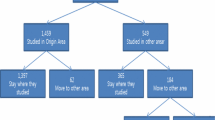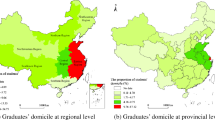Abstract
This paper describes an investigation that used data from a census of Chinese graduates to understand the decisions made by graduates migrating from their home region to their first jobs after graduation. Employing a two-stage estimation method, we found that the economic conditions and social amenities are crucial determinants in attracting non-native graduates, and the improvement of innovation level can also help attract more graduates. In addition, low demand for graduates, low innovation level, and poor transportation conditions of cities are the main causes of out-migration of native graduates.
Similar content being viewed by others
References
Anjomani A, Hariri V (1992) Migration stock and the issue of competing and complementary flows in united states interstate migration. J Popul Econ 5:87–100
Arzaghi M, Rupasingha A (2013) Migration as a way to diversify: evidence from rural to urban migration in the U.S. J Reg Sci 53:690–711
Cebula RJ (2005) Internal migration determinants: recent evidence. Int Adv Econ Res 11:267–274
Chan KW, Buckingham W (2008) Is china abolishing the hukou system? China Q 195:582–606
Coniglio ND, Prota F (2007) Human capital accumulation and migration in a peripheral eu region: the case of basilicata. Papers Reg Sci 87:77–96
Corcoran J, Faggian A, Mccann P (2010) Human capital in remote and rural Australia: the role of graduate migration. Growth Change 41:192–220
Di Pietro G (2005) On migration and unemployment: evidence from italian graduates. Econ Issues 10:11–28
Dotti NF, Fratesi U, Lenzi C, Percoco M (2013) Local labour markets and the interregional mobility of italian university students. Spat Econ Anal 8:443–468
Faggian A, Franklin RS (2014) Human capital redistribution in the usa: the migration of the college-bound. Spat Econ Anal 9:376–395
Faggian A, Mccann P, Sheppard S (2006) An analysis of ethnic differences in UK graduate migration behaviour. Ann Reg Sci 40:461–471
Faggian A, Mccann P, Sheppard S (2007a) Human capital, higher education and graduate migration: an analysis of Scottish and Welsh students. Urban Stud 44:2511–2588
Faggian A, Mccann P, Sheppard S (2007b) Some evidence that women are more mobile than men: gender differences in UK graduate migration behavior. J Reg Sci 47:517–539
Florida R (2002) The economic geography of talent. Ann Assoc Reg Geogr 92:734–755
Frankel JA, Stein E, Wei SJ (1997) Regional trading blocs in the world economic system. Institute for International Economics, Washington DC
Fu Y, Gabriel SA (2011) Labor migration, human capital agglomeration and regional development in china. Reg Sci Urban Econ 42:473–484
Goss J, Lindquist B (1995) Conceptualizing international labour migration: a structuration perspective. Int Migr Rev 29:317–351
Gottlieb PD, Joseph G (2006) College to work migration of technology graduates and holders of doctorates within the united states. J Reg Sci 46:627–659
Greenwood MJ (1969) An analysis of the determinants of geographic labor mobility in the United States. Rev Econ Stat 51:189–194
Guimaraes P, Figueirdo O, Woodward D (2003) A tractable approach to the firm location decision problem. Rev Econ Stat 85:201–204
Guimoto CZ, Sandron F (2001) The internal dynamics of migration networks in developing countries. Popul Engl Sel 13:135–164
Haug S (2008) Migration networks and migration decision-making. J Ethnic Migr Stud 34:585–605
Iammarino S, Marinelli E (2014) Education-job (mis) match and interregional migration: Italian university graduates’ transition to work. Reg Stud 49:866–882
Jayet H, Ukrayinchuk N, De Arcangelis G (2010) The location of immigrants in Italy: disentangling networks and local effects. Ann Econ Stat 97(98):329–350
Jayet H, Rayp G, Ruyssen I, Ukrayinchuk N (2016) Immigrants’ location choice in Belgium. Ann Reg Sci 57:63–89
Liang Z (2001) The age of migration in china. Popul Dev Rev 27:499–524
Liu Y, Shen JF (2014a) Jobs or amenities? Location choices of interprovincial skilled migrants in China, 2000–2005. Popul Space Place 20:592–605
Liu Y, Shen JF (2014b) Spatial patterns and determinants of skilled internal migration in China, 2000–2005. Pap Reg Sci 93:749–771
Liu Y, Shen JF, Xu W, Wang GX (2016) From school to university to work: migration of highly educated youths in China. Ann Reg Sci 59:651–676
Ma KR, Kang ET, Kwon OK (2017) Migration behavior of students and graduates under prevailing regional dualism: the case of South Korea. Ann Reg Sci 58:209–233
Marinelli E (2010) Graduates on the move: knowledge flows and italian regional disparities. Migration patterns of 2001 graduates. PhD thesis, The London School of Economics and Political Science
Marinelli E (2011) Graduate migration in Italy: Lifestyle or necessity? ERSA
Mcfadden D (1974) Conditional logit analysis of qualitative choice behavior. In: Zarembka P (ed) Frontiers in econometrics. Academic Press, New York, pp 105–142
OECD (2004) Education at a glance. OEOD, Paris
Peeters L (2012) Gravity and spatial structure: the case of interstate migration in Mexico. J Reg Sci 52:819–856
Polachek SW, Bargain O (2006) The influence of stocks and flows on migrants’ location choices. Res Labor Econ 26:199–229
Ritsila J, Ovaskainen M (2001) Migration and regional centralization of human capital. Appl Econ 33:317–325
Rowe F, Corcoran J, Faggian A (2013) Mobility patterns of overseas human capital in Australia: the role of a new graduate visa scheme and rural development policy. Aust Geogr 44:177–195
Rutten R, Gelissen J (2008) Technology, talent, diversity and the wealth of European regions. Eur Plan Stud 16:985–1006
Sun YF, Pan KF (2014) Prediction of the intercity migration of Chinese graduates. J Stat Mech Theory Exp 2014:P12022
Tano S (2014) Regional clustering of human capital: school grades and migration of university graduates. Ann Reg Sci 52:561–581
van Dalen HP, Henkens K (2007) Longing for the good life: understanding emigration from a high-income country. Popul Dev Rev 33:37–65
Venhorst VA, van Dijk J, van Wissen LJK (2010) Do the best graduates leave the peripheral areas of the netherlands? Tijdschr Econ Soc Geogr 101:521–537
Venhorst VA, van Dijk J, van Wissen L (2011) An analysis of trends in spatial mobility of Dutch graduates. Spa Econ Anal 6:57–82
Vertovec S (2002) Transnational networks and skilled labour migration. Migration, Ladenburg
Windmeijer FAG, Silva JMCS (1997) Estimation of count data models with endogenous regressors: an application to demand for health care. J Appl Econ 12:281–294
Acknowledgements
This study was supported by the MOE (Ministry of Education in China) Project of Humanities and Social Sciences (Project No. 16YJCZH088) and National Natural Science Foundation of China (Grant Numbers 71804184).
Author information
Authors and Affiliations
Corresponding author
Additional information
Publisher's Note
Springer Nature remains neutral with regard to jurisdictional claims in published maps and institutional affiliations.
Rights and permissions
About this article
Cite this article
Sun, YF., Pan, KF. & He, ZL. Intercity migration behavior of Chinese graduates: from home region to work destination. Ann Reg Sci 64, 111–132 (2020). https://doi.org/10.1007/s00168-019-00958-3
Received:
Accepted:
Published:
Issue Date:
DOI: https://doi.org/10.1007/s00168-019-00958-3




